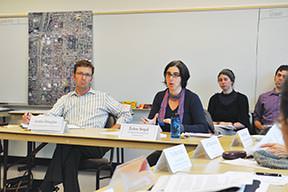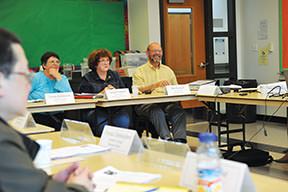 |
||||||||
| MEMO BLOG | Memo Calendar | Memo Pad | Business Memos | Meals on Wheels | Letters | Home | ||
LEE PERLMAN
THE MID-COUNTY MEMO
 |
| Portland Development Commission's Justin Douglas, left, who was the former senior project manager for the Gateway Urban Renewal Regional Center project is now a policy manager at the urban renewal agency. |
 |
| Until the Portland Development Commission disbanded the group, Bob Earnest, right, was co-chair of the Program Advisory Committee-the citizens group that advised PDC on its work in Gateway. Mid-county Memo photos/Tim Curran |
The members of the three neighborhood districts, including Lents and Gateway (whose group was named Gateway Program Advisory Committee) were given a group farewell at PDC by Board Chair Scott Andrews and Executive Director Patrick Quinton. They were told that some of their members might be appointed to a newer citizen body, the Neighborhood Economic Development Leadership Group.
A week later, the leaders of four inner city district URACs were also summoned to PDC. However, since the agency has not yet devised a comparable body to the NEDLG, these URACs may continue for a while before officially disbanding.
PDC's Justin Douglas, who worked for the agency in Gateway, says the reason for the change is partly logistical and economic, and partly due to a change in PDC's purpose and orientation. There has been a drastic reduction in the agency's size, he told the Memo, and the current budget contains only a single outreach position.
“The URACs were created in an era when PDC had a much larger budget and a different agenda,” Douglas says. Now, they are more narrowly focused on economic development and job creation rather than a broader agenda for community revitalization. People concerned with issues such as transportation would do best to work with partner agencies such as the Portland Bureau of Transportation, he says.
Bob Earnest, chair of Opportunity Gateway, says he is “disappointed and concerned about how PDC will solicit public input. It's a shame it happened, and it cements the idea that east Portland does not count.”
“We remain wholeheartedly committed to public participation,” Douglas says. “That doesn't necessarily need to be through the URACs. We will create project-specific advisory committees for major projects.” Moreover, he repeats, URAC members will be considered for the new NEDLG “provided they have some sort of supportive background” or skill in business management, commercial development, economic development, neighborhood revitalization, or community leadership. PDC is also prepared to work with groups such as neighborhood associations or the East Portland Action Plan. “Just coming together for cookies and coffee once a month is not the only way,” Douglas says.
“The new group has my full support,” Earnest says. “But my experience is in managing public agencies. I'm not a builder, a developer or a property owner. I don't fit their criteria. Am I interested in applying? I don't think so.” Instead, there is talk that the East Portland Action Plan may assume aspects of the committee's functions.
As a long-time member, Earnest has seen the Gateway District founder as it failed to generate enough tax increment to create the basic infrastructure that experts, like the consultants Parametrix (Douglas's former employer), said was necessary to attract development, leaving the district in a continuous conundrum.
“We've fared better than Lents,” he says. “We have more brick and mortar to show for our time.” He cites some new development projects such as Glisan Commons and the work of developer Gordon Jones. There are also the improvements to Northeast 102nd Avenue, although he says the new facilities are not well kept-up. “Development in Gateway will happen in my lifetime,” he says.
Despite the required Master Plan for a new park in Gateway, there is no funding to build it, at least in the near future. However, Earnest says, “We deserve the equivalent of Elizabeth Caruthers Park” in the South Waterfront.
A contributing problem was that some of Gateway's already scarce Tax Increment Financing were spent for things that the URAC did not feel were local priorities. Five million dollars were allocated for the MAX light rail Green Line to Clackamas Town Center. Another million went to creating the Children's Receiving Center, making a prime development location at East Burnside Street and 102nd Avenue forever tax-exempt. The CRC proved economically unviable and was abandoned. The property has now become the Gateway Center for Domestic Violence Services. Some local activists consider this an improvement, since the new facility at least generates visitors. Earnest is not happy with the center's use of the name Gateway, which he feels contributes to branding the area as the home of poor people, social services and their headquarters offices.
 |
 |
 |
MEMO Advertising | MEMO Archives | MEMO Web Neighbors | MEMO Staff | Home
